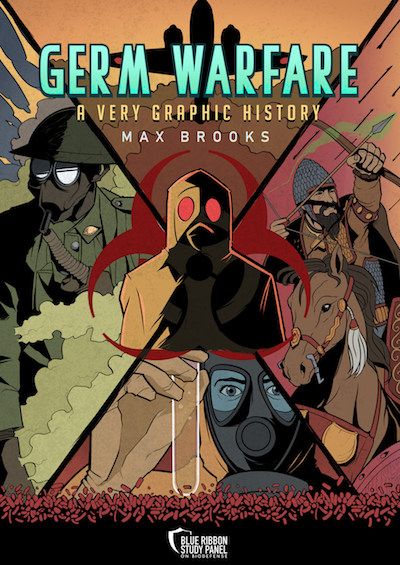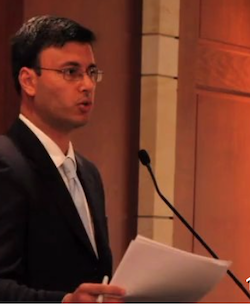biodefense
See the following -
A 'Very Graphic History' Of Germ Warfare
 Max Brooks, best-selling author of "World War Z" and non-resident fellow at the Modern War Institute at West Point, has partnered with the Blue Ribbon Study Panel on Biodefense to produce GERM WARFARE: A Very Graphic History. This highly stylized and engaging graphic novel, set for release this Saturday, depicts previous biological warfare events, the possibilities for the future, and the continued need for public health security. This is part of an effort by the bipartisan Panel to educate the public about biological risks and why a strong biodefense enterprise is critical to the health and security of the Nation.
Max Brooks, best-selling author of "World War Z" and non-resident fellow at the Modern War Institute at West Point, has partnered with the Blue Ribbon Study Panel on Biodefense to produce GERM WARFARE: A Very Graphic History. This highly stylized and engaging graphic novel, set for release this Saturday, depicts previous biological warfare events, the possibilities for the future, and the continued need for public health security. This is part of an effort by the bipartisan Panel to educate the public about biological risks and why a strong biodefense enterprise is critical to the health and security of the Nation.
- Login to post comments
Anthrax Blunder Reveals Deadly Potential Of Accidents
A lab director has reportedly been reassigned and other heads at the U.S. Center for Disease Control are likely to roll after an incident earlier this month in which at least 75 staff members may have accidentally been exposed to live samples of anthrax being transported from one lab to another....
- Login to post comments
Bipartisan Commission on Biodefense Issues Call For a National Public Health Data System
 In April 2022 the Bipartisan Commission on Biodefense released a new report titled The Athena Agenda: Advancing the Apollo Program for Biodefense. Established in 2014, the privately-funded commission convenes periodically and conducts research to assess the state of US biodefense efforts and to make recommendations for change and improvement. Spurred by the events surrounding the COVID-19 pandemic, this report challenges the country to prepare itself for future pandemics by establishing aggressive goals, gathering our “best and brightest” talent, developing action-oriented plans, and funding their accomplishment as the “next Apollo Program.”
In April 2022 the Bipartisan Commission on Biodefense released a new report titled The Athena Agenda: Advancing the Apollo Program for Biodefense. Established in 2014, the privately-funded commission convenes periodically and conducts research to assess the state of US biodefense efforts and to make recommendations for change and improvement. Spurred by the events surrounding the COVID-19 pandemic, this report challenges the country to prepare itself for future pandemics by establishing aggressive goals, gathering our “best and brightest” talent, developing action-oriented plans, and funding their accomplishment as the “next Apollo Program.”
- Login to post comments
Blue Ribbon Study Panel On Biodefense Receives $2.5 Million Grant To Reduce Risk of Catastrophic Bioweapon Disease Outbreaks
 The Blue Ribbon Study Panel on Biodefense announced today a $2.5 million grant from the Open Philanthropy Project. The grant allows the Panel to continue its leadership role in assessing our nation’s biodefense, issuing recommendations and advocating for their implementation, and identifying viable avenues for needed change to policy. The grant comes amidst heightened global tensions as North Korea and other regimes seek to develop biological weapons. It also arrives on the 100th anniversary of a catastrophic influenza pandemic that took the lives of millions around the world, a stark reminder of the dangers of biological events.
The Blue Ribbon Study Panel on Biodefense announced today a $2.5 million grant from the Open Philanthropy Project. The grant allows the Panel to continue its leadership role in assessing our nation’s biodefense, issuing recommendations and advocating for their implementation, and identifying viable avenues for needed change to policy. The grant comes amidst heightened global tensions as North Korea and other regimes seek to develop biological weapons. It also arrives on the 100th anniversary of a catastrophic influenza pandemic that took the lives of millions around the world, a stark reminder of the dangers of biological events.
- Login to post comments
Blue Ribbon Study Panel Recognizes National Security Strategy, Calls for Comprehensive Approach
 Senator Joseph Lieberman and Governor Tom Ridge, the co-chairs of the Blue Ribbon Study Panel on Biodefense, today addressed the newly updated U.S. National Security Strategy and the emphasis it places on combatting biological threats to the country. “With the release of the National Security Strategy, the Administration is sending a strong message to our enemies that America takes the biological threat seriously,” said Sen. Lieberman and Gov. Ridge.
Senator Joseph Lieberman and Governor Tom Ridge, the co-chairs of the Blue Ribbon Study Panel on Biodefense, today addressed the newly updated U.S. National Security Strategy and the emphasis it places on combatting biological threats to the country. “With the release of the National Security Strategy, the Administration is sending a strong message to our enemies that America takes the biological threat seriously,” said Sen. Lieberman and Gov. Ridge.
- Login to post comments
Clade X pandemic exercise highlights policies needed to prevent or reduce the worst possible outcomes in future pandemics
 The outbreak of a moderately contagious and moderately lethal novel pathogen precipitated a catastrophic end to the scenario in Clade X, the day-long pandemic tabletop exercise hosted by the Johns Hopkins Center for Health Security on May 15 in Washington, DC. Clade X simulated a series of National Security Council–convened meetings of 10 US government leaders, played by individuals prominent in the fields of national security or epidemic response. Their dialogue as the scenario unfolded addressed significant uncertainties in current prevention and response capabilities, hamstrung by policy challenges at the federal level.
The outbreak of a moderately contagious and moderately lethal novel pathogen precipitated a catastrophic end to the scenario in Clade X, the day-long pandemic tabletop exercise hosted by the Johns Hopkins Center for Health Security on May 15 in Washington, DC. Clade X simulated a series of National Security Council–convened meetings of 10 US government leaders, played by individuals prominent in the fields of national security or epidemic response. Their dialogue as the scenario unfolded addressed significant uncertainties in current prevention and response capabilities, hamstrung by policy challenges at the federal level.
- Login to post comments
DHS-Developed Krona Software Powers Humanitarian Project
 Software originally developed at the at the U. S. Department of Homeland Security’s National Biodefense Analysis and Countermeasures Center (NBACC) to sequence DNA for biodefense is now being used by Microsoft to sequence mosquito DNA in the fight against disease. Developed by the NBACC’s National Bioforensic Analysis Center Genomics Team for bioforensics applications, Krona is a unique visualization tool that enables users to quickly analyze massive quantities of data – such as more than 100 million sequences of DNA in a single mosquito sample, according to Microsoft...
Software originally developed at the at the U. S. Department of Homeland Security’s National Biodefense Analysis and Countermeasures Center (NBACC) to sequence DNA for biodefense is now being used by Microsoft to sequence mosquito DNA in the fight against disease. Developed by the NBACC’s National Bioforensic Analysis Center Genomics Team for bioforensics applications, Krona is a unique visualization tool that enables users to quickly analyze massive quantities of data – such as more than 100 million sequences of DNA in a single mosquito sample, according to Microsoft...
- Login to post comments
National Biodefense Strategy: Protecting the Nation Against all Biological Threats
 Today, the White House and four federal departments unveiled a comprehensive National Biodefense Strategy to make America safer against modern biological threats to the United States. In the 21st century, biological threats are increasingly complex and dangerous, and that demands that we act with urgency and singular effort to save lives and protect Americans. Whether a natural outbreak, an accidental release, or a deliberate attack, biological threats are among the most serious we face, with the potential for significant health, economic and national security impacts. Therefore, promoting our health security is a national security imperative.
Today, the White House and four federal departments unveiled a comprehensive National Biodefense Strategy to make America safer against modern biological threats to the United States. In the 21st century, biological threats are increasingly complex and dangerous, and that demands that we act with urgency and singular effort to save lives and protect Americans. Whether a natural outbreak, an accidental release, or a deliberate attack, biological threats are among the most serious we face, with the potential for significant health, economic and national security impacts. Therefore, promoting our health security is a national security imperative.
- Login to post comments
The Biothreat Is Real — And We’re Not Ready, Report Says
 It's a scary scenario: A genetically engineered Nipah virus is sprayed into the air during a July 4th celebration in Washington, D.C., and across the country, killing more than 6,000 people. A badly prepared United States does almost nothing at first, and people die as officials scramble to get a grip on what happened...
It's a scary scenario: A genetically engineered Nipah virus is sprayed into the air during a July 4th celebration in Washington, D.C., and across the country, killing more than 6,000 people. A badly prepared United States does almost nothing at first, and people die as officials scramble to get a grip on what happened...
- Login to post comments
This mock pandemic killed 150 million people. Next time it might not be a drill
 A novel virus, moderately contagious and moderately lethal, has surfaced and is spreading rapidly around the globe. Outbreaks first appear in Frankfurt, Germany, and Caracas, Venezuela. The virus is transmitted person-to-person, primarily by coughing. There are no effective antivirals or vaccines...So began a recent day-long exercise hosted by the Johns Hopkins Center for Health Security. The simulation mixed details of past disasters with fictional elements to force government officials and experts to make the kinds of key decisions they could face in a real pandemic. It was a tense day. The exercise was inspired in part by the troubled response to the Ebola epidemic of 2014, and everyone involved was acutely aware of the very real and ongoing Ebola outbreak spreading in Congo.
A novel virus, moderately contagious and moderately lethal, has surfaced and is spreading rapidly around the globe. Outbreaks first appear in Frankfurt, Germany, and Caracas, Venezuela. The virus is transmitted person-to-person, primarily by coughing. There are no effective antivirals or vaccines...So began a recent day-long exercise hosted by the Johns Hopkins Center for Health Security. The simulation mixed details of past disasters with fictional elements to force government officials and experts to make the kinds of key decisions they could face in a real pandemic. It was a tense day. The exercise was inspired in part by the troubled response to the Ebola epidemic of 2014, and everyone involved was acutely aware of the very real and ongoing Ebola outbreak spreading in Congo.
- Login to post comments
Using Open Technology To Build a Biodefense Against the Coronavirus
 As the number of US cases of the coronavirus rises, how will healthcare professionals be able to tell the difference between which panicked patients with similar symptoms has what? Even if the patient hasn't traveled to Wuhan or China recently, what if they sat at a Starbucks with someone who did? With the incubation time-lag before symptoms appear, who would even know? The challenge of monitoring 330 million people for infectious disease outbreaks is daunting. Take the flu as an example. During the last flu season which, as already discussed, was not as complex as this year's season, approximately 35.5 million Americans had flu symptoms, 16.5 million received medical care, 490,600 were hospitalized and 34,200 died.
As the number of US cases of the coronavirus rises, how will healthcare professionals be able to tell the difference between which panicked patients with similar symptoms has what? Even if the patient hasn't traveled to Wuhan or China recently, what if they sat at a Starbucks with someone who did? With the incubation time-lag before symptoms appear, who would even know? The challenge of monitoring 330 million people for infectious disease outbreaks is daunting. Take the flu as an example. During the last flu season which, as already discussed, was not as complex as this year's season, approximately 35.5 million Americans had flu symptoms, 16.5 million received medical care, 490,600 were hospitalized and 34,200 died.
- Login to post comments